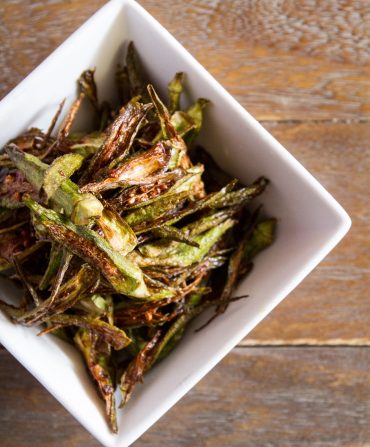Editor’s note: The following is an excerpt from the G&G book S Is for Southern: A Guide to the South, from Absinthe to Zydeco. A compendium of Southern life and culture, the book contains nearly five hundred entries spanning every letter of the alphabet.
The story of okra is a long one. A quintessentially Southern food, as the chef and author Virginia Willis describes it in her eponymous cookbook on the subject, it seems as Southern as field peas and collard greens. It has long been demeaned for its sliminess, and at times marginalized as one of those “Southern things.” But cooks knew it far outside the South, and most likely for thousands of years, before a single green pod ever reached these parts.
A relative of both cotton and hibiscus, as its delicate flower suggests, okra had its beginnings, scholars believe, in equatorial Africa, in the Sahel region south of the Sahara, ranging from Mali eastward to Ethiopia. Cooks there prize it as a thickener as well as a vegetable, and it appears in a continent-wide array of dishes, among them Egypt’s bamia (an okra stew that can be prepared with lamb or beef or served as a vegetarian side dish) and Senegal’s soupikandia, a soupy stew that is an ancestor of gumbo. Indeed, the word gumbo is a corruption of the words for the vegetable in the Bantu languages of Central Africa, tchingombo and ochingombo. (To this day, anyone who wants okra in any French-speaking region need only ask for gombo.) From the continent’s midsection, the plant made its way to Mediterranean shores—first cultivated in Egypt perhaps as long ago as 2000 BC—before winning hearts and stomachs in the Middle East and beyond. It is prized as bhindi, or lady’s fingers, in India.
No one is sure exactly where, when, or how okra made its way to the Western Hemisphere, although enslaved Africans generally get credit. There is evidence of the plant in Brazil in 1658, and it most likely arrived in the southern United States via the Caribbean. It reached Louisiana in the early 1700s, and also appeared in Charleston, South Carolina, early on. Thomas Jefferson noted its cultivation in Virginia before 1781 (and planted it in his own gardens at Monticello in 1809, after his presidency). By 1824, it was well known enough to appear in several recipes in Mary Randolph’s The Virginia Housewife, the most notable of them entitled simply “Gumbs: A West India Dish”—steamed okra pods served with melted butter, which Randolph deemed “very nutritious and easy of digestion.” Jefferson’s family had okra recipes that were soupy stews containing ingredients such as potatoes, squash, onions, lima beans, parsley, and occasionally tomatoes. Bacon was used for seasoning, and chicken was added later, as were veal, corn, and green peppers. The results probably resembled a Charleston gumbo more than a Louisiana one.
It seems that no one lacks an opinion about okra. Admirers praise its thickening abilities and versatile flavor; detractors cannot get past its mucilaginous properties. The vegetable can be fried, steamed, stewed, boiled, pickled, and even eaten raw or blanched in a salad. It is especially prized, though, as the thickener for soups and rich gumbo of the type served in South Louisiana. These days, okra is also gaining acceptance beyond the South, as chefs and cooks throughout the country discover its versatility through myriad international and Southern recipes and find new uses for the pod that is one of Africa’s gifts to the cooking of the New World.
S Is for Southern is available at Amazon, Fieldshop, IndieBound, and in bookstores everywhere.








